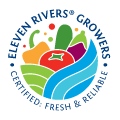Know more about the Eleven Rivers Certification Squeme: obtention, use, management and water quality

Axis II: Agriculture Production System section 2.4 Water Obtention, Use, Management and Quality
2.3.1. Water source and irrigation methods
The source of water supply and irrigation methods for production blocks or lots should be documented, and should include: maps, images, layouts or other means to report the location of water sources.
Water systems for agriculture use should not have a cross-link with animal or human wastes.
2.3.2. Water Flow Chart
A water flow chart needs to be developed, describing the circulation trend: from the beginning until its final use; and indicate the treatments received during its storage.
The locations of the fixed devices comprising the complete irrigation system in the field should be documented: wells, gates, dams, valves, strainers, and control systems (reservoirs and dams).
2.3.3. Water management plan
A water management plan including the following should be documented: water supply risk analysis, monitoring program, preventive actions, verification and control procedures, cleaning and maintenance programs, sampling plan and analysis results. This plan should be reviewed and updated when adjustments or changes occur and after assessing risks on the water system.
When the source of water is an open source (e.g., Irrigation channel, river, natural reservoirs), one should include in the water management plan the preventive and corrective actions, the parameters for the control and verification of water sources, and the control measures prior to water access. In addition, grids should be installed to prevent animal access (e.g., turtles, fish, and alligators) or other pollutants (e.g., wood, garbage).
A water use and management procedure should be developed, including a monitoring program, to avoid the use of open sources for showering, washing clothes and appliances or grazing animals. This monitoring activity should be documented in their relevant records.
2.3.4. Water monitoring program
A monitoring program should be developed, indicating the analysis frequency of water sources used by the company (channels, wells, municipal system). These analyses should be performed by an accredited laboratory according to ISO/IEC-17025 regulation.
The water monitoring program should consist on obtaining samples during harvest and production season. This should include sampling frequency, name of the person who is taking samples, the place where samples are taken, how they are collected, the type of test and acceptance criteria, in accordance with official reference standards.
2.3.5. Water quality for irrigation
Irrigation water should be obtained from a safe or treated source, to ensure its safety. A risk analysis of the irrigation water supply should be documented: start from its origin to its final use, using the water’s flow chart tool.
After developing the treatment of irrigation water, in order to determine if its use is acceptable, compliance with microbiological standards should be verified: the geometric mean of samples is equal or less than 126 UFC of generic E. coli per 100 ml of water and the statistical threshold of samples is equal or less than 410 UFC of generic E. coli per 100 ml of water, plus the absence of Salmonella.
2.3.6. Water for human consumption in the field
Water should be provided for field workers’ consumption, through the use of tanks and developing a cleaning and hygiene supervision procedures.
Hygienic measures for water storage and distribution should be considered, including wash and disinfection; the manner in which water is provided should ensure that no common cup is used among workers.


